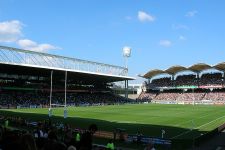The Stade de Gerland (known for sponsorship reasons as Matmut Stadium de Gerland and otherwise known as Municipal de Gerland or Stade Gerland [stad ʒɛʁlɑ̃]) is a stadium in the city of Lyon, France which serves as home to Top 14 rugby club Lyon OU. It has a seating capacity of 35,000.
Situated in the Gerland quarter, it was used by French professional football club Olympique Lyonnais, who moved to the newly constructed Parc Olympique Lyonnais in 2016. Local rugby union club Lyon OU moved in beginning of 2017, replacing their much smaller stadium Matmut Stadium. The stadium's capacity was also reduced from 43,000 to a more reasonable 35,000.
The Stade de Gerland is listed as a Category three stadium by UEFA's standards and has hosted matches for the 1954 and 1972 Rugby League World Cups, UEFA Euro 1984, the 1998 FIFA World Cup, and the 2007 Rugby World Cup.
The stadium has hosted concerts by many famous artists, including The Rolling Stones, Michael Jackson, David Bowie, Pink Floyd and Genesis.
History
In 1910, the mayor of Lyon, Edouard Herriot, came up with the idea to develop and build a sports stadium with an athletics track and a velodrome in the city. In 1912, the stadium was officially mandated and local architect Tony Garnier was given the reins to designing and constructing it. Construction began in 1914 with hopes that the stadium would be completed before the International Exhibition of 1914. However, due to World War I, construction was temporarily halted, but resumed following the wars conclusion in 1919 with the assistance of a large number of German POWs. By 1920, the stadium was completely functional. In 1926, the Stade de Gerland was inaugurated by Herriot.
The stadium originally had a cycling track, but it was removed in order to increase the seating capacity to 50,000. In 1984, minor renovations were made to the stadium by architect Rene Gagis in order to bring the stadium up to standards for UEFA Euro 1984. This included construction of the Jean Bouin a
